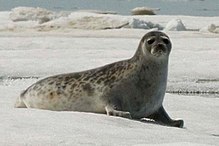Ring seal
| Ringed seal | |
|---|---|
 |
|
| Scientific classification | |
| Kingdom: | Animalia |
| Phylum: | Chordata |
| Clade: | Synapsida |
| Class: | Mammalia |
| Order: | Carnivora |
| Suborder: | Caniformia |
| Clade: | Pinnipedia |
| Family: | Phocidae |
| Genus: | Pusa |
| Species: | P. hispida |
| Binomial name | |
|
Pusa hispida (Schreber, 1775) |
|
 |
|
| Synonyms | |
|
|
|
The ringed seal (Pusa hispida or Phoca hispida), also known as the jar seal and as netsik or nattiq by the Inuit, is an earless seal (family: Phocidae) inhabiting the Arctic and sub-Arctic regions. The ringed seal is a relatively small seal, rarely greater than 1.5 m in length, with a distinctive patterning of dark spots surrounded by light grey rings, hence its common name. It is the most abundant and wide-ranging ice seal in the Northern Hemisphere: ranging throughout the Arctic Ocean, into the Bering Sea and Okhotsk Sea as far south as the northern coast of Japan in the Pacific, and throughout the North Atlantic coasts of Greenland and Scandinavia as far south as Newfoundland, and include two freshwater subspecies in northern Europe. Ringed seals are one of the primary prey of polar bears and have long been a component of the diet of indigenous people of the Arctic.
The ringed seal is the smallest and most common seal in the Arctic, with a small head, short cat-like snout, and a plump body. Its coat is dark with silver rings on the back and sides with a silver belly, from which this seal gets its vernacular name. Depending on subspecies and condition, adult size can range from 100 to 175 cm (39.5 to 69 in) and weigh from 32 to 140 kg (71 to 309 lb). The seal averages about 5 ft (1.5 m) long with a weight of about 50–70 kg (110–150 lb). This species is usually considered the smallest species in the true seal family, although several related species, especially the Baikal seal, may approach similarly diminutive dimensions. Their small front flippers have claws more than 1 inch (2.5 cm) thick that are used to maintain breathing holes through 6.5 ft (2.0 m) thick ice.
...
Wikipedia

